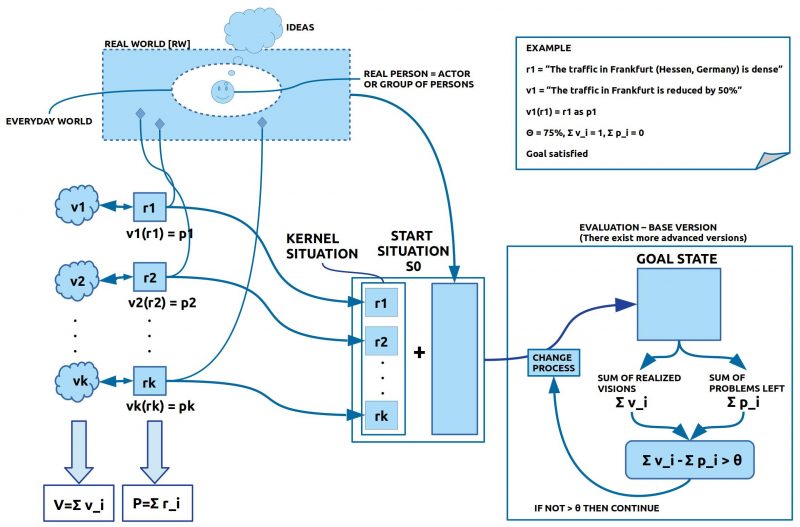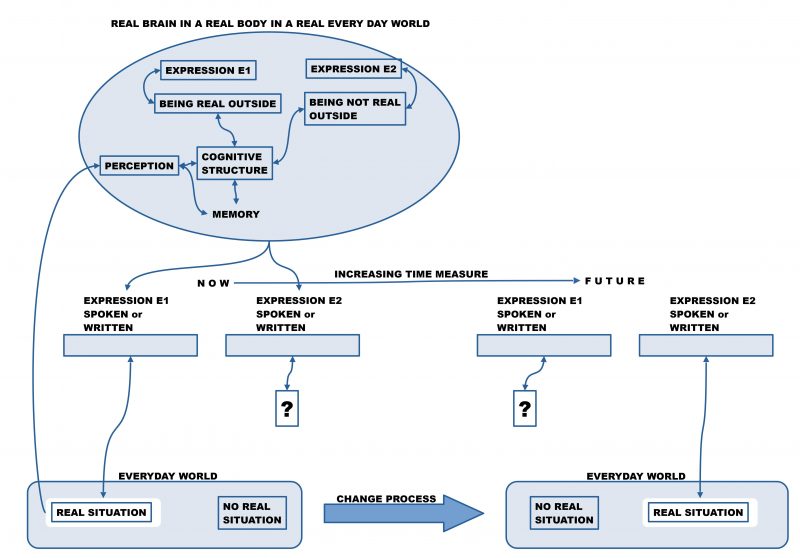Integrating Engineering and the Human Factor (info@uffmm.org)
eJournal uffmm.org ISSN 2567-6458, March 2, 2021,
Author: Gerd Doeben-Henisch
Email: gerd@doeben-henisch.de
Last change: March 2, 2021 13:59h (Minor corrections)
HISTORY
As described in the uffmm eJournal the wider context of this software project is an integrated engineering theory called Distributed Actor-Actor Interaction [DAAI] further extended to the Collective Man-Machine Intelligence [CM:MI] paradigm. This document is part of the Case Studies section.
HMI ANALYSIS, Part 3: Actor Story and Theories
Context
This text is preceded by the following texts:
- HMI ANALYSIS, Part 2: Problem & Vision (Feb 27, 2021 at 11:30h)
- HMI Analysis for the CM:MI paradigm. Part 1 (Feb 25, 2021 at 12:08)
Introduction
Having a vision is that moment where something really new in the whole universe is getting an initial status in some real brain which can enable other neural events which can possibly be translated in bodily events which finally can change the body-external outside world. If this possibility is turned into reality than the outside world has been changed.
When human persons (groups of homo sapiens specimens) as experts — here acting as stakeholder and intended users as one but in different roles! — have stated a problem and a vision document, then they have to translate these inevitably more fuzzy than clear ideas into the concrete terms of an everyday world, into something which can really work.
To enable a real cooperation the experts have to generate a symbolic description of their vision (called specification) — using an everyday language, possibly enhanced by special expressions — in a way that it can became clear to the whole group, which kind of real events, actions and processes are intended.
In the general case an engineering specification describes concrete forms of entanglements of human persons which enable these human persons to cooperate in a real situation. Thereby the translation of the vision inside the brain into the everyday body-external reality happens. This is the language of life in the universe.
WRITING A STORY
To elaborate a usable specification can metaphorically be understood as the writing of a new story: which kinds of actors will do something in certain situations, what kinds of other objects, instruments etc. will be used, what kinds of intrinsic motivations and experiences are pushing individual actors, what are possible outcomes of situations with certain actors, which kind of cooperation is helpful, and the like. Such a story is called here Actor Story [AS].
COULD BE REAL
An Actor Story must be written in a way, that all participating experts can understand the language of the specification in a way that the content, the meaning of the specification is either decidable real or that it eventually can become real. At least the starting point of the story should be classifiable as being decidable actual real. What it means to be decidable actual real has to be defined and agreed between the participating experts before they start writing the Actor Story.
ACTOR STORY [AS]
An Actor Story assumes that the described reality is classifiable as a set of situations (states) and a situation as part of the Actor Story — abbreviated: situationAS — is understood as a set of expressions of some everyday language. Every expression being part of an situationAS can be decided as being real (= being true) in the understood real situation.
If the understood real situation is changing (by some event), then the describing situationAS has to be changed too; either some expressions have to be removed or have to be added.
Every kind of change in the real situation S* has to be represented in the actor story with the situationAS S symbolically in the format of a change rule:
X: If condition C is satisfied in S then with probability π add to S Eplus and remove from S Eminus.
or as a formula:
S’π = S + Eplus – Eminus
This reads as follows: If there is an situationAS S and there is a change rule X, then you can apply this change rule X with probability π onto S if the condition of X is satisfied in S. In that case you have to add Eplus to S and you have to remove Eminus from S. The result of these operations is the new (successor) state S’.
The expression C is satisfied in S means, that all elements of C are elements of S too, written as C ⊆ S. The expression add Eplus to S means, that the set Eplus is unified with the set S, written as Eplus ∪ S (or here: Eplus + S). The expression remove Eminus from S means, that the set Eminus is subtracted from the set S, written as S – Eminus.
The concept of apply change rule X to a given state S resulting in S’ is logically a kind of a derivation. Given S,X you will derive by applicating X the new S’. One can write this as S,X ⊢X S’. The ‘meaning’ of the sign ⊢ is explained above.
Because every successor state S’ can become again a given state S onto which change rules X can be applied — written shortly as X(S)=S’, X(S’)=S”, … — the repeated application of change rules X can generate a whole sequence of states, written as SQ(S,X) = <S’, S”, … Sgoal>.
To realize such a derivation in the real world outside of the thinking of the experts one needs a machine, a computer — formally an automaton — which can read S and X documents and can then can compute the derivation leading to S’. An automaton which is doing such a job is often called a simulator [SIM], abbreviated here as ∑. We could then write with more information:
S,X ⊢∑ S’
This will read: Given a set S of many states S and a set X of change rules we can derive by an actor story simulator ∑ a successor state S’.
A Model M=<S,X>
In this context of a set S and a set of change rules X we can speak of a model M which is defined by these two sets.
A Theory T=<M,∑>
Combining a model M with an actor story simulator ∑ enables a theory T which allows a set of derivations based on the model, written as SQ(S,X,⊢∑) = <S’, S”, … Sgoal>. Every derived final state Sgoal in such a derivation is called a theorem of T.
An Empirical Theory Temp
An empirical theory Temp is possible if there exists a theory T with a group of experts which are using this theory and where these experts can interpret the expressions used in theory T by their built-in meaning functions in a way that they always can decide whether the expressions are related to a real situation or not.
Evaluation [ε]
If one generates an Actor Story Theory [TAS] then it can be of practical importance to get some measure how good this theory is. Because measurement is always an operation of comparison between the subject x to be measured and some agreed standard s one has to clarify which kind of a standard for to be good is available. In the general case the only possible source of standards are the experts themselves. In the context of an Actor Story the experts have agreed to some vision [V] which they think to be a better state than a given state S classified as a problem [P]. These assumptions allow a possible evaluation of a given state S in the ‘light’ of an agreed vision V as follows:
ε: V x S —> |V ⊆ S|[%]
ε(V,S) = |V ⊆ S|[%]
This reads as follows: the evaluation ε is a mapping from the sets V and S into the number of elements from the set V included in the set S converted in the percentage of the number of elements included. Thus if no element of V is included in the set S then 0% of the vision is realized, if all elements are included then 100%, etc. As more ‘fine grained’ the set V is as more ‘fine grained’ the evaluation can be.
An Evaluated Theory Tε=<M,∑,ε>
If one combines the concept of a theory T with the concept of evaluation ε then one can use the evaluation in combination with the derivation in the way that every state in a derivation SQ(S,X,⊢∑) = <S’, S”, … Sgoal> will additionally be evaluated, thus one gets sequences of pairs as follows:
SQ(S,X,⊢∑,ε) = <(S’,ε(V,S’)), (S”,ε(V,S”)), …, (Sgoal, ε(V,Sgoal))>
In the ideal case Sgoal is evaluated to 100% ‘good’. In real cases 100% is only an ideal value which usually will only be approximated until some threshold.
An Evaluated Theory Tε with Algorithmic Intelligence Tε,α=<M,∑,ε,α>
Because every theory defines a so-called problem space which is here enhanced by some evaluation function one can add an additional operation α (realized by an algorithm) which can repeat the simulator based derivations enhanced with the evaluations to identify those sets of theorems which are qualified as the best theorems according to some criteria given. This operation α is here called algorithmic intelligence of an actor story [αAS]. The existence of such an algorithmic intelligence of an actor story [αAS] allows the introduction of another derivation concept:
S,X ⊢∑,ε,α S* ⊆ S’
This reads as follows: Given a set S and a set X an evaluated theory with algorithmic intelligence Tε,α can derive a subset S* of all possible theorems S’ where S* matches certain given criteria within V.
WHERE WE ARE NOW
As it should have become clear now the work of HMI analysis is the elaboration of a story which can be done in the format of different kinds of theories all of which can be simulated and evaluated. Even better, the only language you have to know is your everyday language, your mother tongue (mathematics is understood here as a sub-language of the everyday language, which in some special cases can be of some help). For this theory every human person — in all ages! — can be a valuable colleague to help you in understanding better possible futures. Because all parts of an actor story theory are plain texts, everybody ran read and understand everything. And if different groups of experts have investigated different aspects of a common field you can merge all texts by only ‘pressing a button’ and you will immediately see how all these texts either work together or show discrepancies. The last effect is a great opportunity to improve learning and understanding! Together we represent some of the power of life in the universe.
CONTINUATION
See here.


